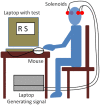A mathematical model and experimental procedure to analyze the cognitive effects of audio frequency magnetic fields
- PMID: 37250701
- PMCID: PMC10218710
- DOI: 10.3389/fnhum.2023.1135511
A mathematical model and experimental procedure to analyze the cognitive effects of audio frequency magnetic fields
Abstract
Audio frequency magnetic fields (20 Hz-20 kHz) are magnetic fields in extremely low frequency-very low frequency (ELF-VLF) bands that are present near audio equipment and acoustic transducers. These devices transform and operate the electrical signal from the recordings or other devices into acoustic and audio signals. The cognitive influence of sound and noise has been widely studied and recognized since the times of ancient Rome; however, the cognitive effects of the magnetic fields of these frequencies have not been studied. Due to the extensive use of audio devices that use this type of transducer near the temporal-parietal area, we believe that it is of interest to study their impact on short-term memory or working memory (WM) and to analyze their potential as they operate as a transcranial magnetic stimulation. In this study, a mathematical model and an experimental tool are introduced to analyze memory performance. The model dissociates the reaction time of a cognitive task. We analyze the model in data from a group of 65 young, healthy subjects. WM is assessed in our experimental setup by means of the Sternberg test (ST), whereby during the ST, one subgroup was exposed to an audio frequency magnetic stimulus, and the other subgroup received a sham stimulus. The magnetic stimulus was ~0.1 μT and was applied to both sides of the head at the frontal cortex near the temporal-parietal area, which is where WM is expected to be located. The ST records reaction times when determining whether an object displayed on the computer screen is one of the objects to be remembered. The results are analyzed within the mathematical model and changes are observed, including the deterioration of WM, which could affect 32% of its operability.
Keywords: audio frequency magnetic fields; cognitive disorders; environmental magnetic fields; magnetic fields; transcranial magnetic stimulation; working memory.
Copyright © 2023 Navarro and Navarro-Modesto.
Conflict of interest statement
The authors declare that the research was conducted in the absence of any commercial or financial relationships that could be construed as a potential conflict of interest.
Figures




References
-
- Atkinson R. C., Shiffrin R. M. (1968). Kenneth W Spence; Janet T Spence (eds.). Human Memory: A Proposed System and its Control Processes. The Psychology of Learning and Motivation. Vol. 2. Austin, TX: University of Texas. pp. 89–195. 10.1016/S0079-7421(08)60422-3 - DOI
-
- Baddeley A. D., Hitch G. (1974). Gordon H. Bower (ed.). Working Memory. The Psychology of Learning and Motivation. Vol. 2. Stanford, CA: Stanford University, pp. 47–89. 10.1016/s0079-7421(08)60452-1 - DOI
LinkOut - more resources
Full Text Sources

